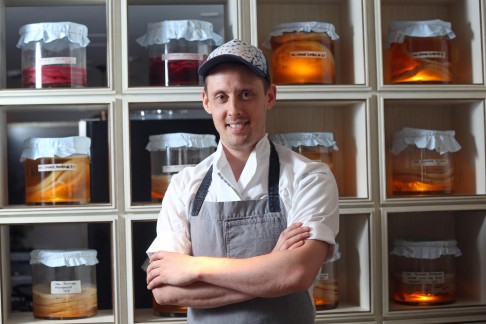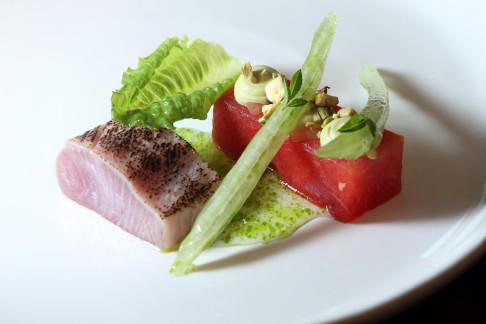
Nurdin Topham of Nur Restaurant experiments with new flavours
Chef explores Asian and European fermentation, pickling and salting techniques, and puts some of them into action on menus; he dreams of having his own food laboratory one day

While you're reading this, Topham is likely to be taking a leaf out of the Noma book and foraging for produce on the outskirts of Copenhagen.
Nur Restaurant's head chef is holidaying in northern Europe, but his influences don't just come from the leader of the new Scandinavian trend, where he worked researching new dishes. The chef, who also worked for Raymond Blanc for 10 years, has a background in nutritional therapy and a longstanding interest in Chinese and other Asian cuisines - influences apparent in his cooking.
Topham has been learning kung fu for 10 years and when he came to Hong Kong three years ago he found a who could teach him not only the martial art but also about tea. The nutritional therapy he studied was based on the Western scientific tradition but he says he also has respect for traditional Chinese medicine and the Ayurvedic tradition. To that end, Topham is now working with a Chinese herbalist, Marcus Gadau.
Located on the corner of Wellington Street and Lyndhurst Terrace, Nur is not too far from the specialist soy sauce shop Pat Chun and many other sources of Chinese fermented and dried goods. "We're still a very young restaurant and our aim is to express something of the region we're in, but that takes time without a food research laboratory, which is my ultimate dream."
We’re still a very young restaurant and our aim is to express something of the region we’re in, but that takes time without a food research laboratory, which is my ultimate dream
That means that despite the aims, the restaurant has so far not moved beyond using Chinese mushrooms and dried scallops and Japanese kombu for stocks. Topham isn't joking about experimenting with Asian food, though. At the back of his restaurant is a large earthenware jar of home-made Korean soy sauce, a test batch definitely not to be given to customers. Topham describes the smell as "funky". A better word for this experiment might be "rank" - as Topham says, "It's not for the faint-hearted."
Topham's interest in these culinary techniques goes beyond his interest in Asian culinary methods - he says the techniques speak to mankind's ingenuity in eking out food when it was not abundant.
He's fascinated by preserving food through salting, and controlling flavour by managing the breakdown of different products such as the starches in vegetables. The Japanese he calls "absolute masters" of the techniques and he points to the long history such techniques have in China and Korea.
So far, so esoteric - but what does the food taste like? Topham says that controlling the rotting process generates all sorts of flavours. Dishes can be sweet and vinegary at the same time. "You have the ability to create food with rich flavours that you don't find in other foods," he says. Speaking as a nutritional therapist, he says preserving foods through salting or fermenting means more nutrients are "bio-available", which is good for general and even mental health. Perhaps for restaurant customers, however, flavour is likely to make more of an impact than nutrition.
The sourness of fermentation is apparent in the restaurant's sourdough bread, made from a 10-year-old starter that is fed every day and contains no artificial yeasts. The bread is a gorgeous chestnut brown with mustard yellow highlights, and exceptionally good.
The tartness and fizz of lactic acid fermentation is apparent in Nur's home-made chilli sauce. The recipe involves removing the seeds and membranes from 10 kilograms of chillies, grilling half of them over charcoal until they blister, then mixing them all with garlic and salt and allowing them to ferment for nine days. This experiment is far more successful than the Korean sauce, producing a well-balanced if slightly mild sauce even without adding any sugar.

American writer Sandor Katz has been a big influence, especially his book , after Topham met him at a conference in Copenhagen. Topham says he encourages all his chefs to read Katz's work because the author is "curious, a keen fermenter, if that's a word, although not a scientist or chef".
Katz's key messages, both supported by Topham, are "Fermentation makes foods more nutritious, as well as delicious" and "Fermented foods help people stay healthy".
Three dishes on the new summer tasting menu (nine courses, HK$1,188) are typical of Topham's approach. Ash gourd - all dishes have one or two word names on the laconic menu - is an appetiser that highlights regional flavours. The gourd is presented as a cube, flavoured with ginger and lemon basil and scented with jasmine from the soup it sits in. It also has the pleasant tang of buttermilk, a by-product of the butter the restaurant churns itself. It has, as Topham says, "a quite gentle flavour and is a soothing dish".
Hamachi is a dish that takes the humane killing of a fish as its starting point. Sparing the gory details, keeps the fish alive until the last possible second and dispatches it with minimal stress, say advocates of the Japanese technique. Topham says fish so killed is fresher and keeps its texture far better. The flesh is given a light cure for half an hour in cucumber, lemon zest, salt and sugar before being seared with a blowtorch, leaving most of the fish raw and allowing its flavour to come through. It is served with watermelon - lightly steamed, of course. Perhaps not a technique that would occur to most chefs, the steaming gives the fruit a meaty texture.
Cherry features cherries from Japan on a flourless pistachio cake, garnished with cherry compote. It's a great dish that contains minimal amounts of sugar. The pistachio purée, enriched with "a little bit of butter and the smallest amount of sugar", is baked to order for each customer. Pastry chef Richard Phillips uses liquorice as a flavouring with an extra fillip - herbalists say it is adaptogenic, meaning it helps the body cope with stress, and soothes and heals the gut.

